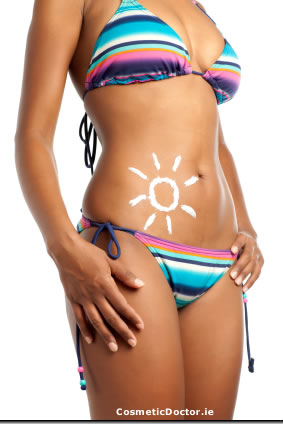Everybody thinks they look better with a tan, but the problem is that tanned skin is often damaged skin. We pale Irish folk seem to be constantly chasing ‘a nice colour’ and many of us are now looking at the unsightly consequences of unprotected exposure.
People think that if they acquire a ‘base’ tan that they will be protected from burning in the strong sun; an idea that seems logical in theory-but the more often you expose your sin, the greater damage you’re doing.
What does Melanin Do?
Melanin is the brown pigment in the epidermis that gives skin colour and protects the deeper layers from sun damage. When the skin is stimulated to make more of it, we get a ‘tan’. Melanin helps absorb and distribute ultraviolet rays to protect you against radiation. If you are very pale and expose yourself to the sun; you’ll get burned, whereas skin with a lot of melanin doesn’t burn as easily.
Sun Protection Vital
The problem is that all exposure to UV light-real sunlight or the tanning beds people are so fond of to ‘build up a base colour’ is damaging to the skin to some extent, and lead to leathery, wrinkle-prone skin. Wearing sunscreen is vital, particularly on the delicate skin of the face, as unprotected skin will get far more damaged, much more quickly.
The sun can also cause an uneven release of melanin, producing spots of dark pigmented areas as well as dilation of small blood vessels.
Tanning Beds age the Skin
In Ireland, where we don’t have much sunshine for most of the year, people turn to indoor tanning beds despite consistent warnings about their use. UVA and UVB rays are both emitted by these beds, and UV radiation is not only a carcinogen, increasing your chances of developing skin cancer, but the strong light from a tanning bed causes premature skin aging.
All Complexions suffer Sun Damage
Although those with medium or dark complexions naturally have more protection than do people with lighter complexions, they will still experience sun damage; increased wrinkles and irregular pigmentation.
The ultraviolet radiation from the sun (and remember, even when it’s cloudy you’re still being exposed to light damage) breaks down the skin’s connective tissue. The collagen and elastin fibres lying in the deeper dermis of your skin are affected.
As skin loses its natural supportive connective tissues, skin starts to sage, strength and flexibility are diminished and creases start to form.
Conditions Caused by Sun Damage
- Liver Spots (lentigines)
- Age/Brown spots (hyperpigmentation)
- Solar elastosis (sagging caused by sun exposure)
- Melasma (‘pregnancy’ mask)
- Poikiloderma (reddish-brown pigmentation)
- Spider Veins
Liver spots have nothing to do with the liver at all; but are flat areas of increased pigmentation, either grey-looking or brown, and can appear in any size, on the face, hands, upper back and other areas that get exposed to the sun on a regular basis. These pigmentation spots develop as we age, but occur in younger people who spend a lot of time in the sun.
Age spots are similar; the brown, hyperpigmented spots appear when melanin distribution is uneven, and can appear anywhere on the face or body that has been exposed to the sun.
Solar Elastosis happens when the connective tissues are damaged by the sun and the skin has nothing to support it any longer; it often happens at the sides of the face and neck, as well as the décolletage.
Melasma is a brownish darkening of facial skin, often referred to as the ‘mask of pregnancy’ as increased female hormones estrogen and progesterone are linked to it, as well as exposure to sunlight. It usually appears on the forehead, cheeks, nose and chin, and worsens with sunlight.
Poikiloderma is an unsightly red-brown pigmentation occurring mainly on the neck and chest; it happens when an area is exposed to sunlight over prolonged periods of time. The skin on the décolletage (top of chest) is inadvertently exposed quite a lot when we wear V-necks tops in the sun, and the tissue is thin and delicate, making it even more susceptible to sun damage.
Spider Veins are enlarged blood vessels close to the surface of the skin, and often occur with extremes of temperature. They become evident as red or purple lines.
Advice from Cosmetic Doctor
Cosmetic Doctor treat all conditions related to sun damage, and will always give you the same advise-don’t forget to wear sunscreen, preferably and SPF of 15 and up, even in cloudy conditions. Year-round, a moisturiser with a built-in SPF as well as foundation with an SPF is the best choice.
To book a skin consultation phone 01 685 3100.


